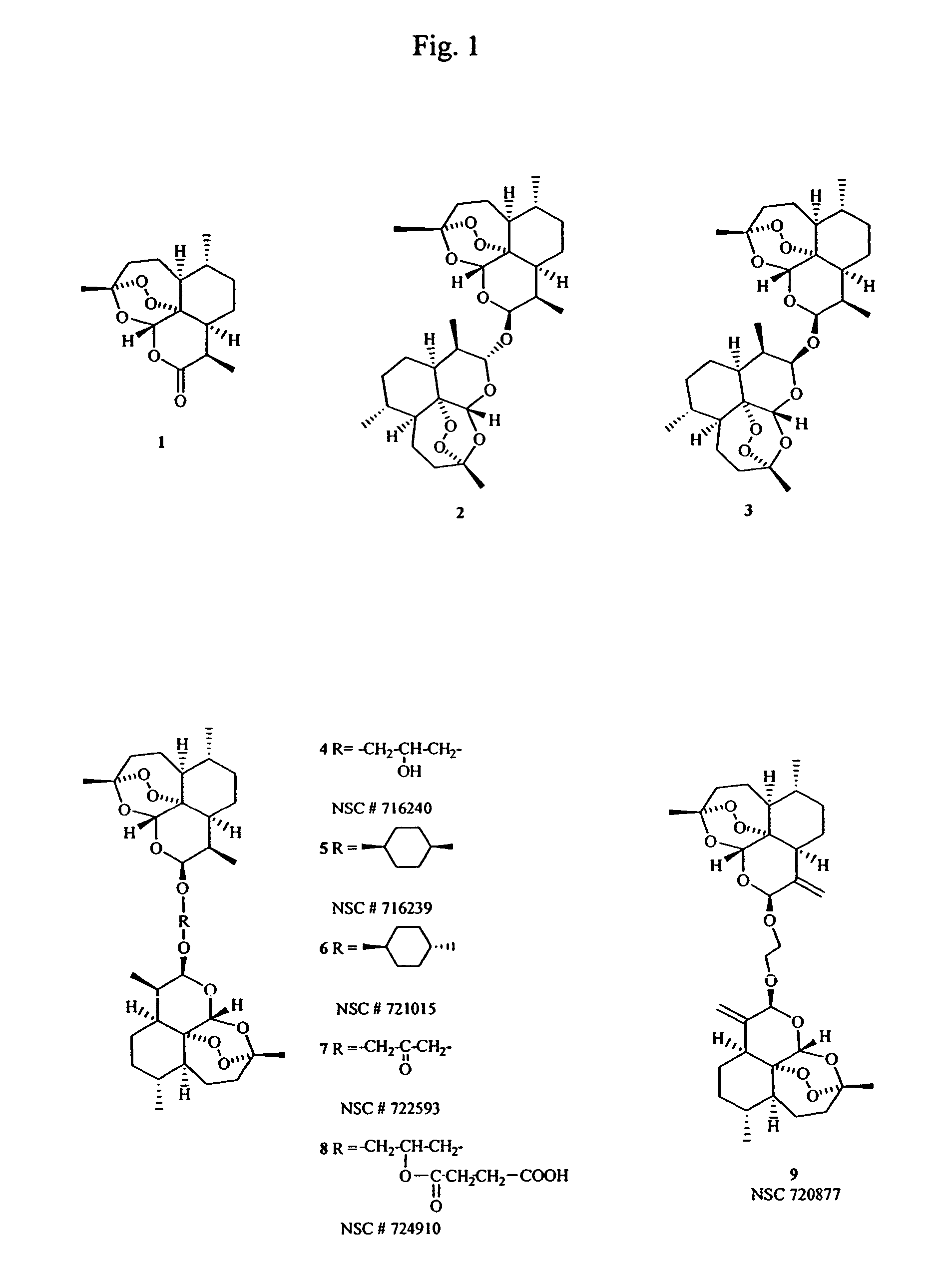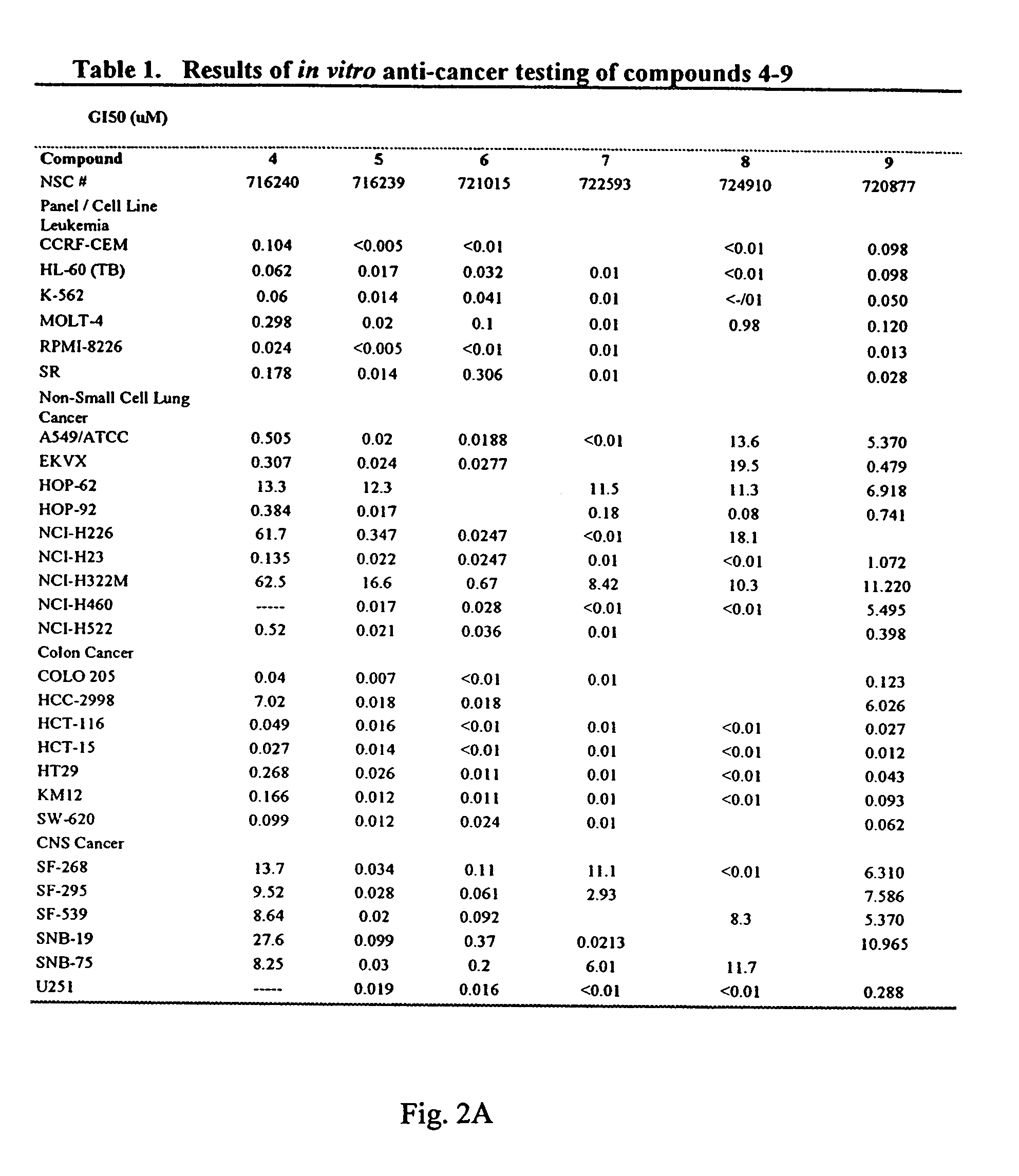Dihydroartemisinin and dihydroartemisitene dimers as anti-cancer and anti-infective agents
- Summary
- Abstract
- Description
- Claims
- Application Information
AI Technical Summary
Problems solved by technology
Method used
Image
Examples
example 1
[0038]To a stirred solution of dihydroartemisinin (160 mg, 0.56 mmol) in a round bottomed flask (50 mL) in dry ether (10 mL), was added dry glycerol (26 mg) and BF3.OEt2 (267μL) using a hypodermic syringe. The mixture was stirred under argon for 70 min. then quenched and worked up as usual to leave a gummy residue (199 mg). Upon crystallization from ether, it yielded 4 (52 mg) as cubic crystals, 28.7%); [α]D+173° (c 0.022, CHCl3); IR (film) vmax:3525 (OH), 2953, 2933, 2881, 1449, 1376, 1194, 1176, 1134, 1107, 1027, 991 cm−1; 1H NMR (CDCl3, 500 MHz, for one of the two identical monomeric units): δ 5.40 (1H, s, H-5), 4.79 (1H, d, J J=3.9, H-12), 4.78 (1H, d, J=3.5 Hz, H-12′), 3.87 (1H, m, H-16, H-16′, H-17), 3.49 (1H, dd, J=5.9, 4.3 Hz, H-18), 3.42 (1H, q, J=5.4 Hz,H-18′), 2.63 (1H, m, H-11), 2.34 (1H, ddd, J=14.0, 4.0, 3.9 Hz, H-3), 2.00 (1H, m, H-3′), 1.85 (1H, m, H-2), 1.68 (3H, m, H-2′, H-8, H-9), 1.46 (2H, m, H-7, H-8′), 1.39 (3H, s, Me-15), 1.34 (1H, m, H-10), 1.21 (1H, m, H-1),...
example 2
[0039]The preferred method of preparing Compound 4 was to first prepare the ketone precursor through condensation of dihydroxyacetone with dihydroartemisinin in the presence of boron trifluoride-etherate followed by sodium borohydride reduction of the resulting ketone to give Compound 4. This is detailed in the following examples.
Preparation of the β,β-Dihydroartemisinin Dimer with Dihydroxyacetone (Compound 7)
example 3
[0040]Dihydroartemisinin (284 mg, 1 mmol) and 1,3-dihydroxyacetone dimer (45.05 mg, 0.25 mmol) were suspended in diethylether (10 mL). To the mixture (cooled to 5° C. under argon) was then added 35.5 mg BF3.Et2O (0.25 mmol, 31 μL) and the mixture stirred at 5° C. for 20 minutes then at room temperature for 1 hr. Workup as usual gave 319 mg of residue.
[0041]The residue was chromatographed on silica gel column (30 g) and eluted with hexane:EtOAC (95:5) with polarity increasing to 80:20. Fractions were collected and pooled according to TLC similarities to give four major fractions. The most polar fraction (140.2 mg) was identified as Compound 7 (converts to Compound 4 upon NaBH4 reduction): 1H-NMR in CDCl3 at 500 MHz: δ 5.44 (2H, s, H-5 & H-5′), 4.805 (2H, d, J=3.39 Hz, H-12 & H-12′), two broad doublets (2H each J=17.59) centered at δ 4.46 & 4.285 (H-16 & H-18),2.665 (2H, m, H-11 & H-11′), 2.355 (2H, ddd, H-3), 2.025 (2H, m, H-3′), 1.88 (2H, m, H-2), 1.81 (4H, m, H-9 & H-9′), 1.675 (2H...
PUM
| Property | Measurement | Unit |
|---|---|---|
| thickness | aaaaa | aaaaa |
| temperature | aaaaa | aaaaa |
| temperature | aaaaa | aaaaa |
Abstract
Description
Claims
Application Information
 Login to View More
Login to View More - R&D
- Intellectual Property
- Life Sciences
- Materials
- Tech Scout
- Unparalleled Data Quality
- Higher Quality Content
- 60% Fewer Hallucinations
Browse by: Latest US Patents, China's latest patents, Technical Efficacy Thesaurus, Application Domain, Technology Topic, Popular Technical Reports.
© 2025 PatSnap. All rights reserved.Legal|Privacy policy|Modern Slavery Act Transparency Statement|Sitemap|About US| Contact US: help@patsnap.com



